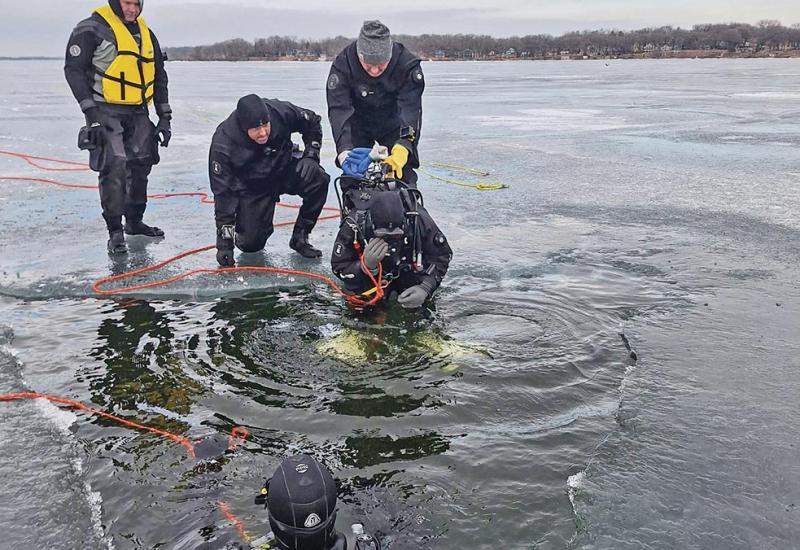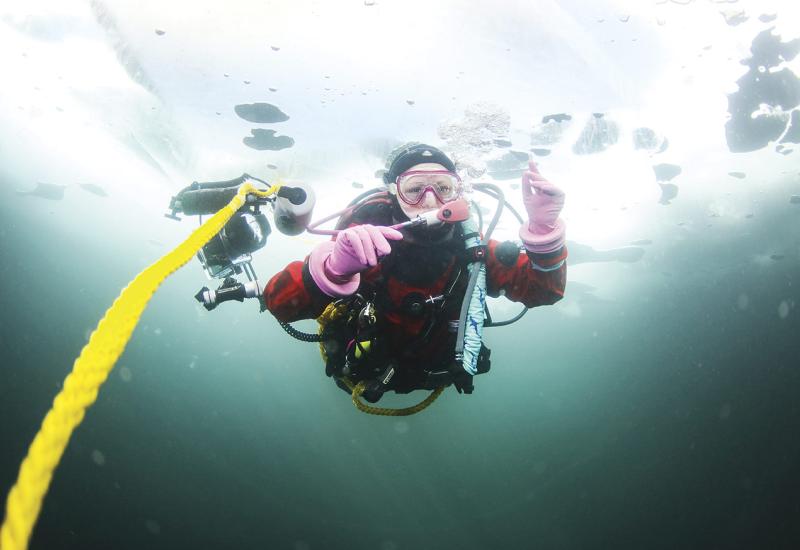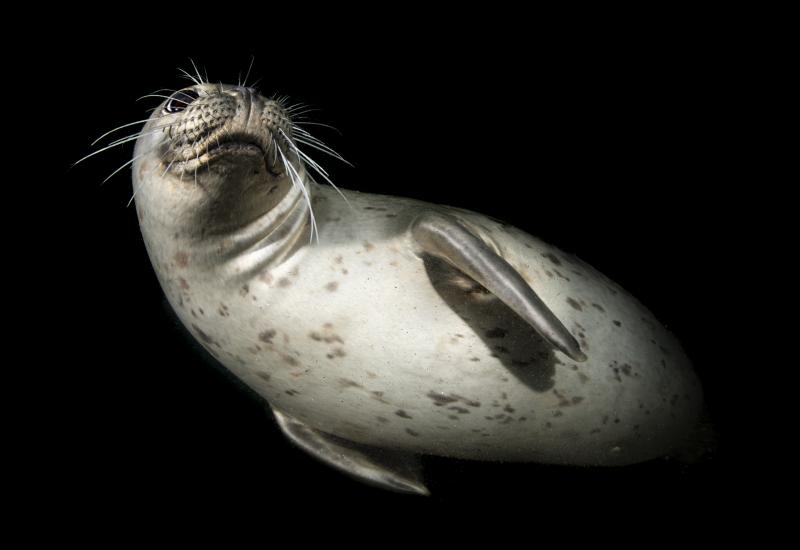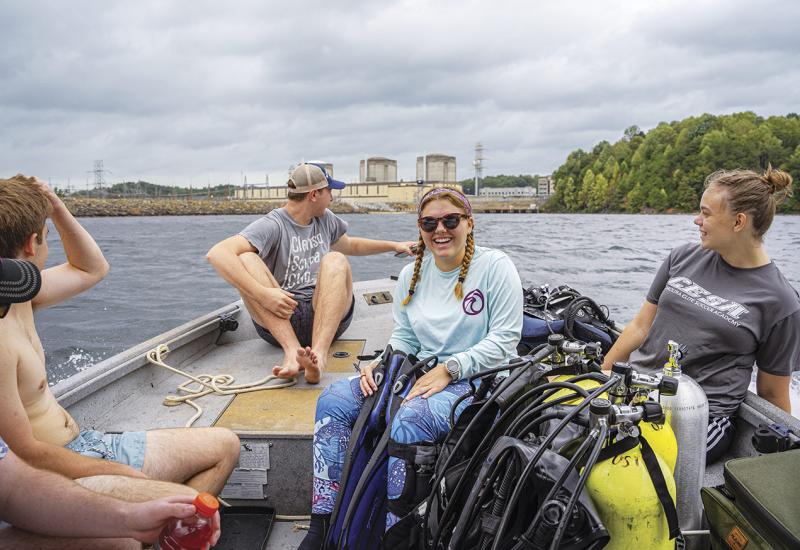Scuba Diving the Flower Garden Banks
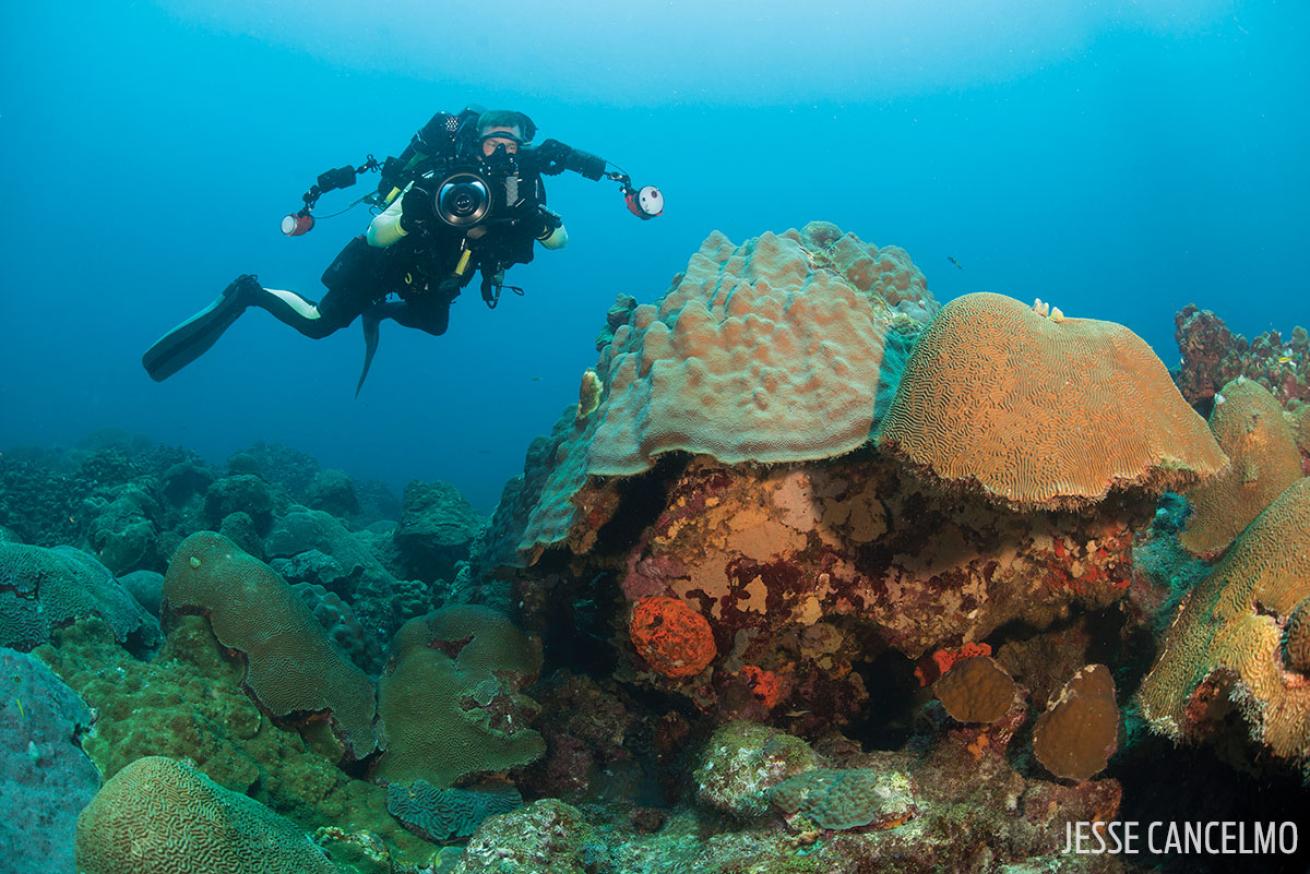
Jesse CancelmoCoral reefs aren't just for the Caribbean — Texas has them too. See for yourself at the Flower Garden Banks National Marine Sanctuary.
At Stetson Bank’s buoy No. 3, the dive begins low-key at a stretch of reef between the mooring U-bolt and the north drop-off . This is where the reef-top is a flattened, vanilla-colored area of claystone ridges with its signature striated geological claw marks. The outcroppings are speckled with sea urchins and encrusted sponges in a palette of reds, yellows and blues.
Finning along the guide line, I spot a couple of arrow crabs crawling around, while juvenile damselfish flutter and flit above the moonscape-looking bottom. When the spectacular formation of ten-ray star coral (Madracis decactis) comes into view, I know I’m near the bluewater drop-off . Spotted morays and schooling creolefish and snapper on this magnificent coral feature make for plenty of distractions, but I have my focus on the open blue ahead, hoping to see a manta ray, loggerhead turtle or even a sandbar shark cruise by.
Just as I arrive at the point where the 80-foot-deep reef plunges to nearly 200 feet, I am stunned to see the massive body of a scalloped hammerhead shark swimming solo toward me on a 12 o’clock heading. I manage to ready my camera, and the 12-foot shark fills my frame before it turns and darts away into the deep.
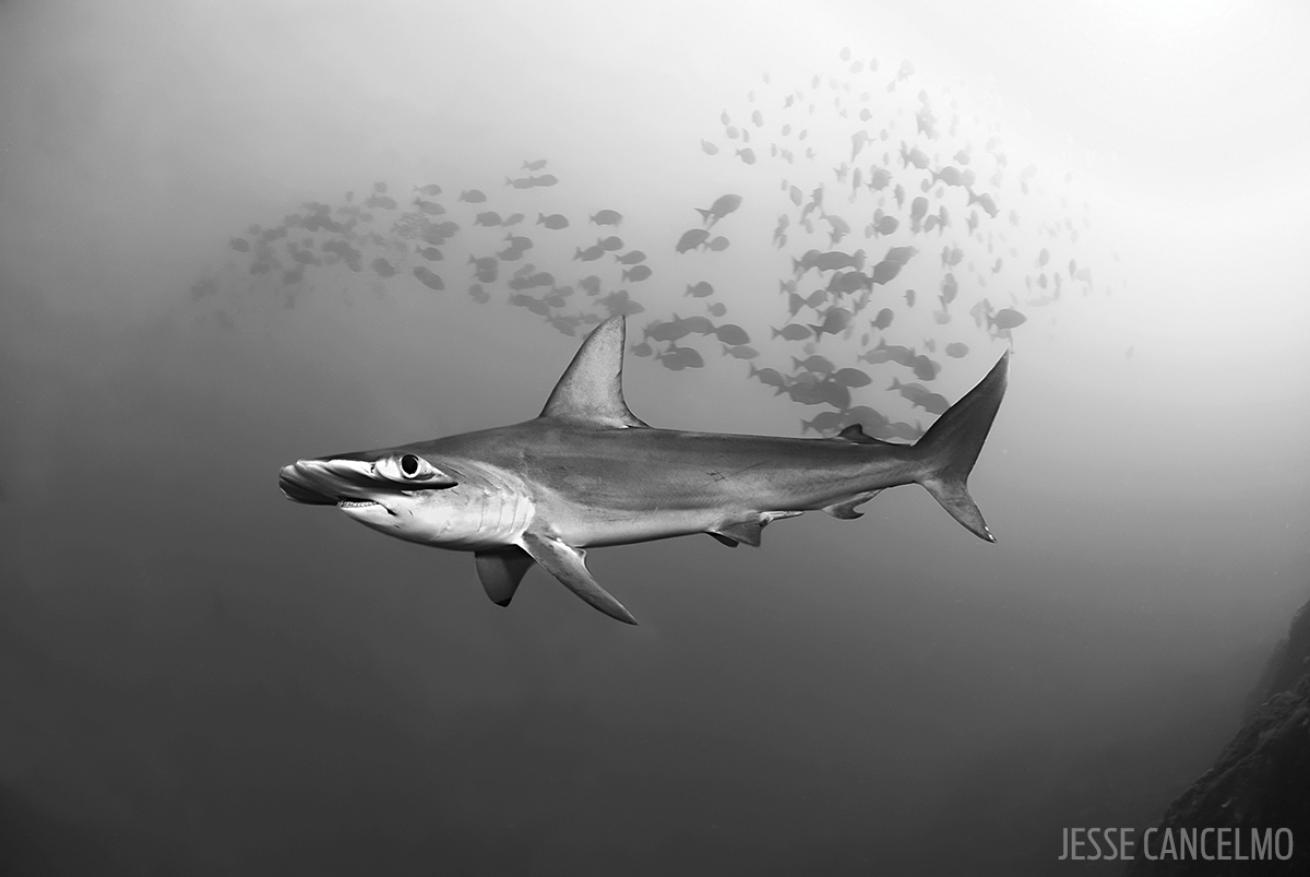
Jesse CancelmoHammerhead season at the Flower Garden Banks runs February through May.
Stetson Bank is the third reef of the Flower Garden Banks National Marine Sanctuary trio of jewels located in the northwestern Gulf of Mexico, 75 to 115 miles off the Texas coast. All of the sanctuary reefs sit atop salt domes formed 190 million years ago; unlike its two cousins 35 miles away, Stetson Bank has a base of siltstone and claystone rather than a limestone substrate produced by corals.
The reef habitat is about 36 acres and has a series of sponge- and fire-coral-cloaked pinnacles jutting 10 feet high along the northern side of its crest. Known as a northern Gulf hot spot for fish-watching and photography, Stetson is home to several remarkable fishes such as sailfin blennies, golden (morphed) smooth trunkfish and even longlure frogfish.
The East and West Flower Garden Banks, 13 miles apart, are the northernmost coral reefs on America’s continental shelf. At 28 degrees above the equator, it’s a miracle of nature that allows just the right combination of Gulf Stream eddies with steady food supplies, a hard surface, temperature, and light to charge these small and isolated mounds. They rise to a depth of 65 feet from the surface and produce thriving coral communities — the nearest live-coral reef is 400 miles away.
They remain somewhat off the radar for many divers, yet “healthy,” “sustainable” and “near pristine” are descriptors used by divers who know these two exceptional coral reefs. The crests at both banks are composed of a dense array of hard corals, mostly brain and star corals, many of them massive, boulder-shaped formations that create a majestic living seascape of wonderful forms and hues.
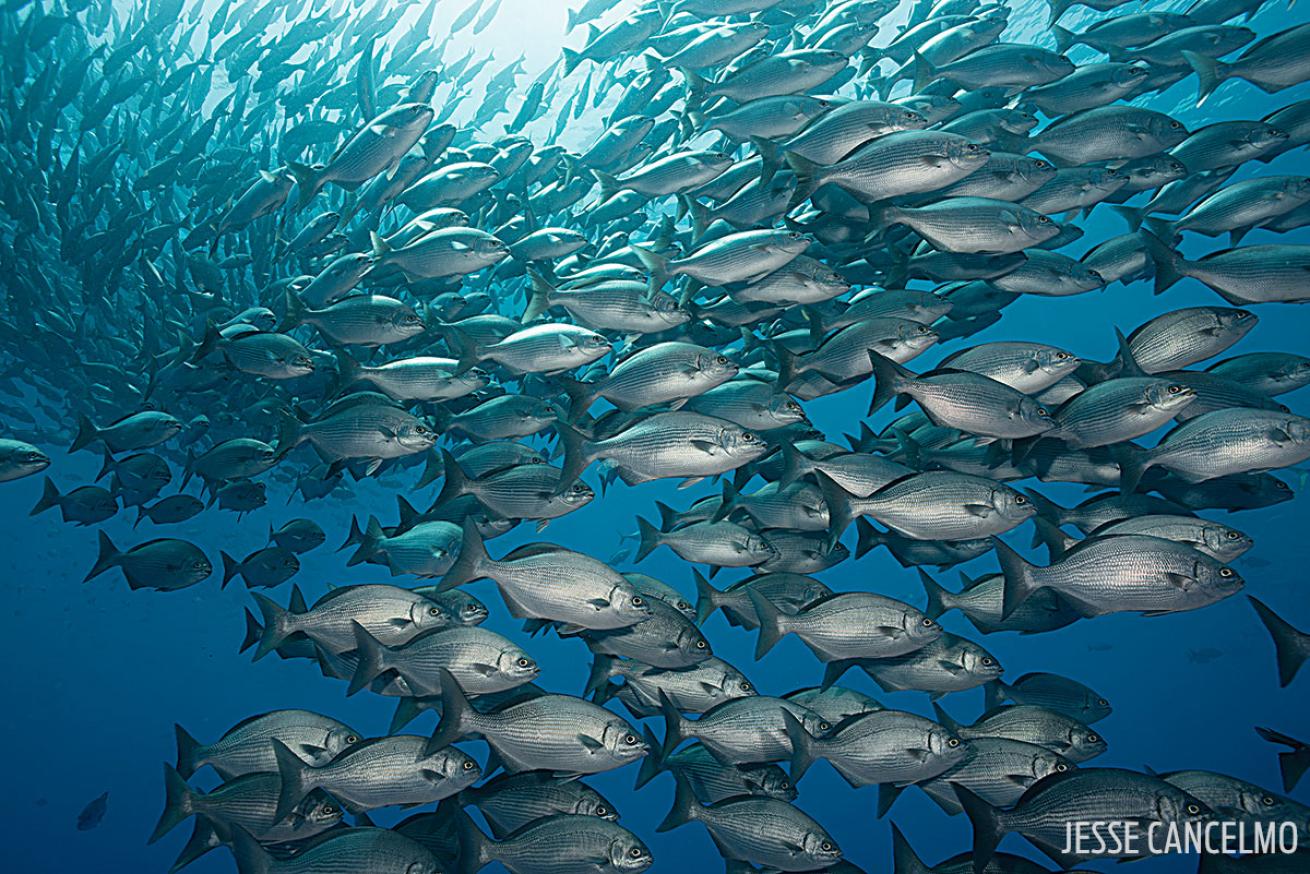
Jesse CancelmoA school of Bermuda chub congregate at Stetson Bank.
A BLOW, AND RECOVERY
Sanctuary researchers report its live-coral cover (with 22 different species) is a remarkable 51 percent, and that has not declined since the annual measurements began nearly three decades ago, making these reefs some of the healthiest coral reefs in the entire Western Hemisphere. Unfortunately, in July 2016, this remarkable success was stung by a mortality event that affected corals and invertebrates in a localized area of the East Flower Garden Bank reef (affecting only 1.5 percent of the reef).
Also, last summer the sanctuary endured persistent higher-than-normal water temps, resulting in coral bleaching or paling at both banks. The good news: As of November 2016, sanctuary researchers report no mortalities from the bleaching, and they hope for a full recovery. The cause of the July mortality event remains undetermined but has not spread beyond the original impact area.
Beyond its corals, the sanctuary’s tropical-fish community includes spotted drum, scrawled cowfish, cocoa damselfish and yellowfin grouper, to name just a few of the more than 250 fish species in this diverse habitat. Manta rays are spotted on a regular basis at both Flower Garden Banks. Sanctuary staff are collaborating with the Wildlife Conservation Society in a manta ray (and shark) tagging effort. These giant pectoral-winged filter feeders sometimes circle for an hour or more. The shows they put on for divers can happen down on the reef or at a deco stop 15 feet from the surface.
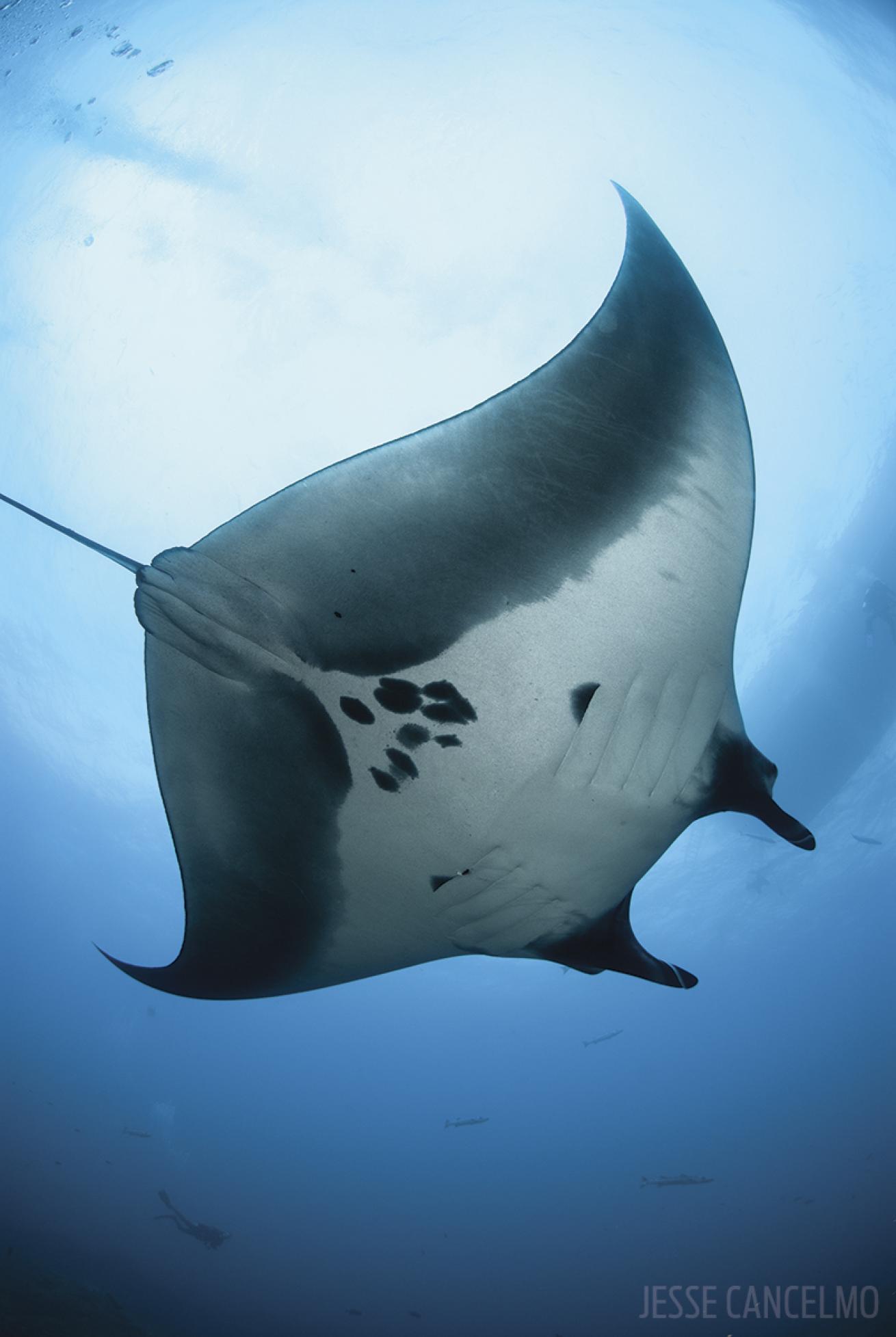
Jesse CancelmoScientists are gathering data about the mantas in the Flower Garden Banks.
One of the hottest dives at the Gardens occurs during the cooler months from February to mid- April. This is when hammerhead sharks congregate at the East and West Flower Garden Banks. Not a guarantee, but a winter diver at the sanctuary offers a good chance to see a scalloped hammerhead, several or even a Galapagos-like school. In the summer months, whale sharks cruise through the Gardens on an irregular basis; more than a few divers on their first-ever offshore trip have encountered the largest fish in the ocean.
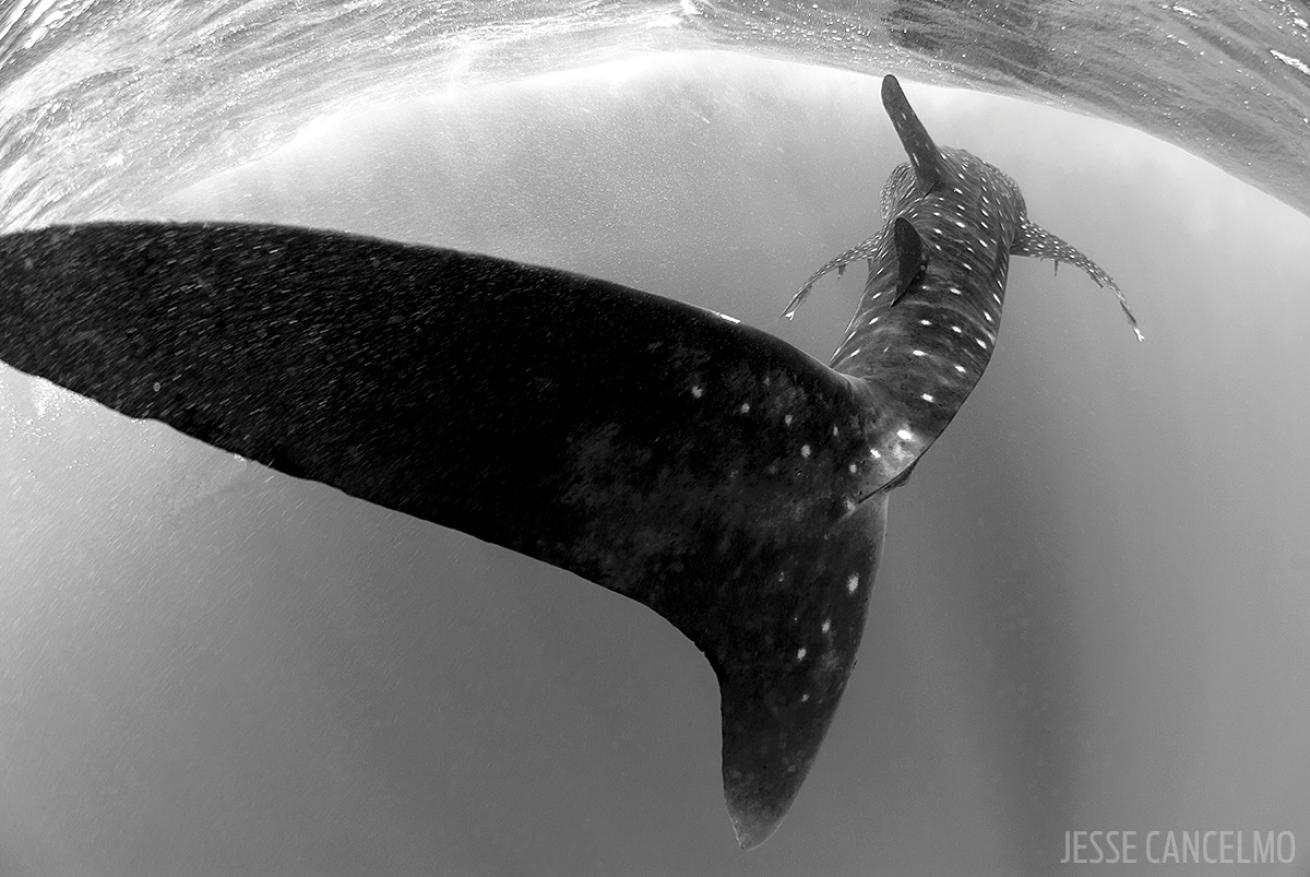
Jesse CancelmoWhale sharks tend to cruise through the Flower Garden Banks in the summer months.
Perhaps the most spectacular ocean-animal event at the sanctuary is the annual phenomenon known as coral spawning. This magic trick of nature occurs very predictably eight to 10 nights after the August full moon, when broadcasting corals release gamete packages of eggs and sperm that rise in the water column in a spectacular display across the reef. It’s a blizzard of animal life in the making.
For an off-the-radar dive locale that’s only a road trip away — with a fair chance of sighting a manta ray, having a coral-reef experience like no other or maybe bumping into a hammerhead or whale shark — head to Texas and experience the glory of the Gulf.
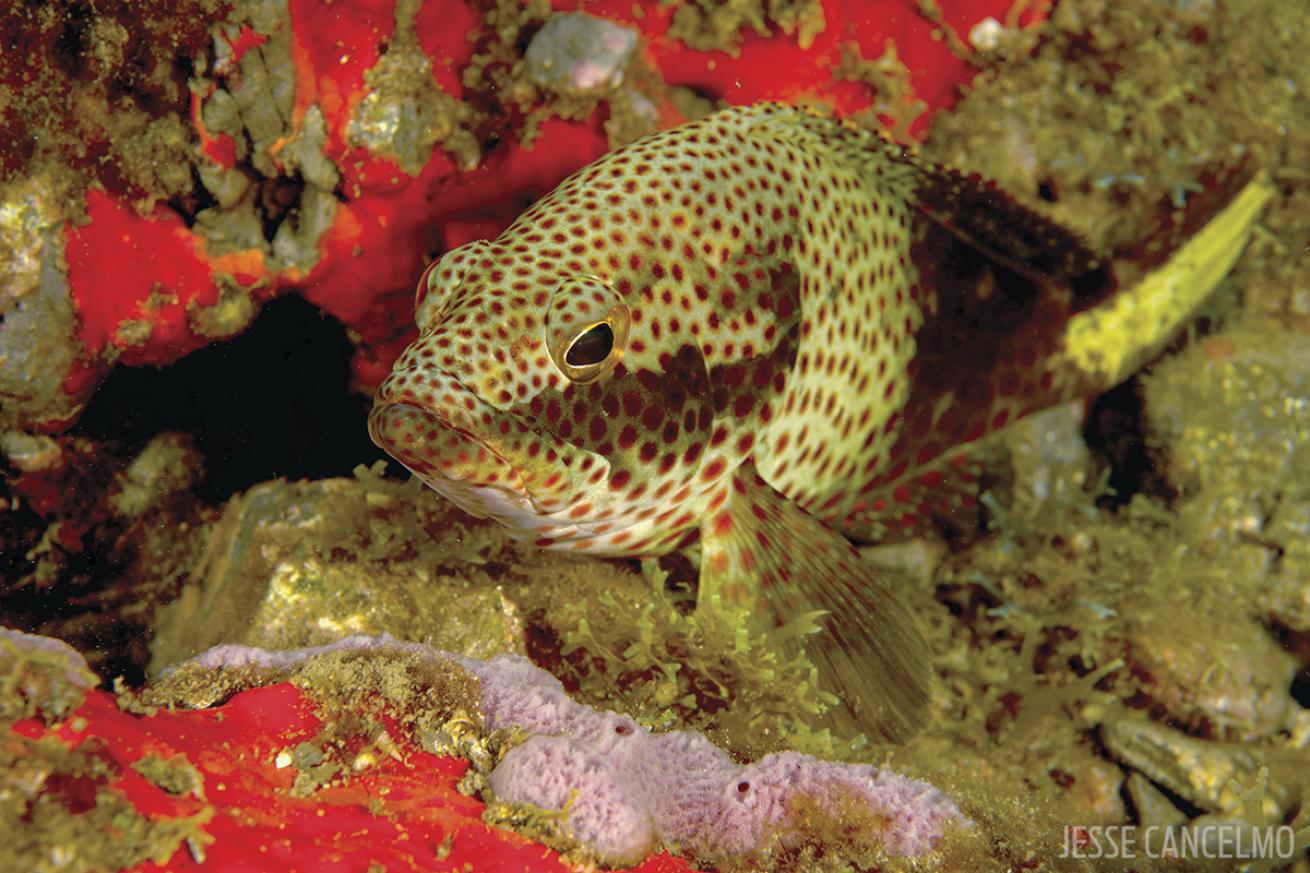
Jesse CancelmoStetson Bank has a totally different reefscape than East and West Flower Garden Banks.
NEED TO KNOW
WHEN TO GO Winter season, aka hammerhead season, runs February through May, weekends only (hammerhead sightings drop off mid- to late April). Summer season runs from June through late October. Two- and three-day liveaboard trips are offered Monday- Wednesday, Thursday-Friday or Saturday- Sunday in summer through Labor Day. After Labor Day, it’s weekends only.
DIVE CONDITIONS Water temps are in the high 60s to high 70s in winter; low to mid- 80s in summer. Viz is from 30 to 60 feet in winter and 75 to 100-plus feet in summer.
OPERATORS Fling Charters runs winter weekend and summer two- and three-day trips on M/V Fling from Freeport, Texas. Texas Bluewater Safaris runs four-pax charters, one-day Stetson Bank and two-day Flower Garden Banks, out of Surfside Marina.
PRICE TAG Two-day Fling trips (seven dives) start at $585 for weekends; $535 for Thursday- Friday; Monday-Wednesday liveaboard trips (11 dives) start at $670. Stetson Bank one-day full-boat four-pax charters on Bluewater Safaris runs $1,700 total. Two-day Bluewater Safaris full-boat four-pax charters to the Flower Garden Banks reefs run $2,400 total.
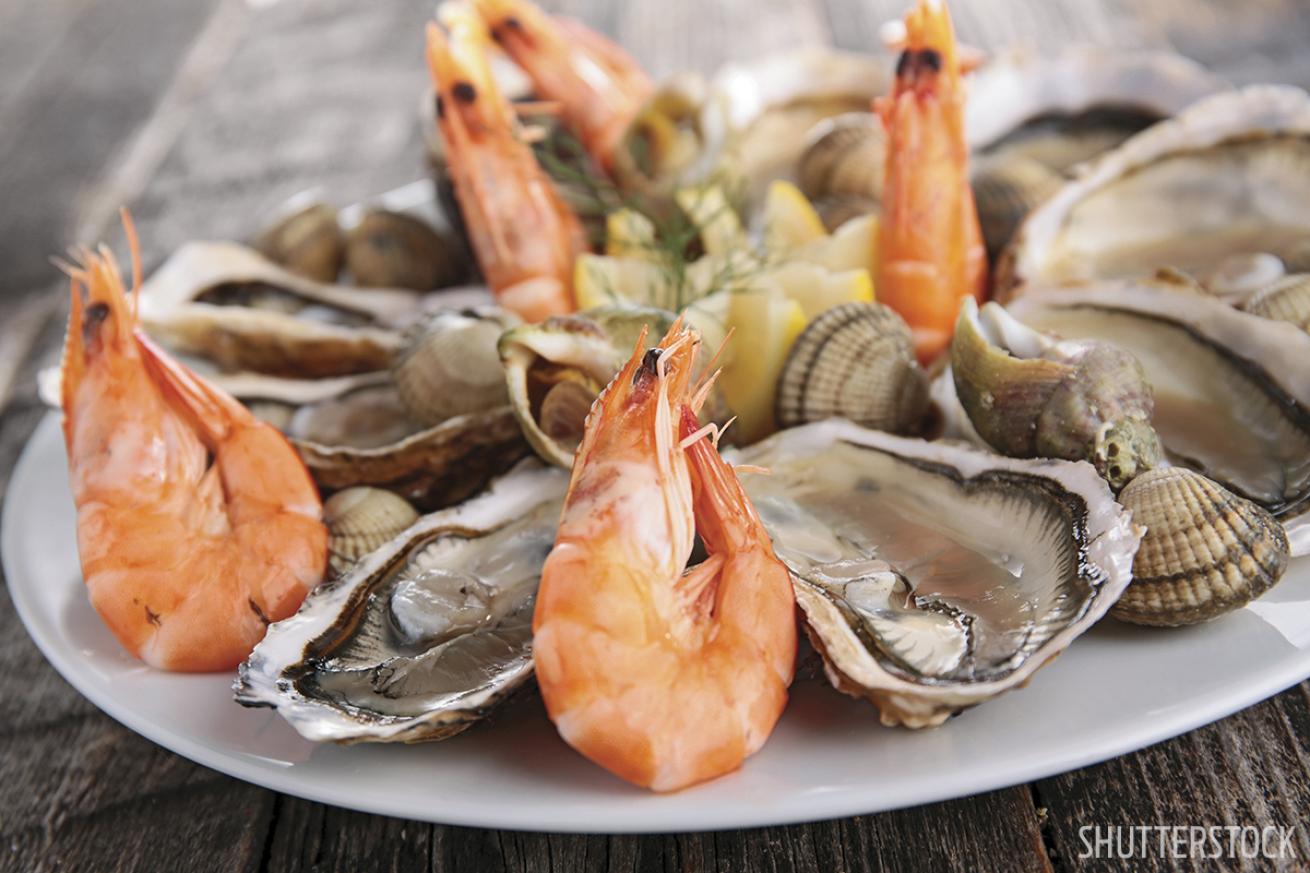
ShutterstockMake sure to leave plenty of time to dig into some fresh Texas Gulf shrimp and oysters during your trip.
ITINERARY
DAY ONE From Houston’s George Bush or Hobby airport, head south on Highway 288 toward Freeport. If an overnight is needed, choose any of the affordable options — Clarion Inn, Hampton Inn or La Quinta Inn near Lake Jackson. If not, head directly to M/V Fling for a 7:30 p.m. arrival. Allow time to sample fresh Texas Gulf shrimp and oysters with a side of hush puppies at the Baytown Seafood restaurant or at On the River across the street from the dock.
DAY TWO The first dive on the West Flower Garden Bank reef is at 7 a.m. A hot breakfast with pancakes, eggs or tacos awaits you after surfacing. Two-and-a-half-hour surface intervals allow time to lounge in the salon or on the upper deck. After the second dive, there’s time for reading, satellite TV or a snooze during the 13-mile run to a platform dive near the East Flower Garden Bank reef. The late-afternoon dive is followed by a Texas-size dinner: beef brisket, fajitas or pasta. After the night dive, enjoy warm brownies with whipped cream and a side of ice cream before heading to the upper deck to gaze at a glorious sky full of constellations.
DAY THREE Stetson Bank is a totally different reefscape from the East and West Flower Garden Banks. With its “moon surface” look, it offers rocky uplifts, sponge-encrusted pinnacles, and schools of snapper and chub. An added bonus is the steep drop-off on the north side near buoys No. 1 to No. 3. Lunch is served after the second dive as the boat begins the five-hour run back to Freeport. Arrival is typically 5 to 6 p.m.
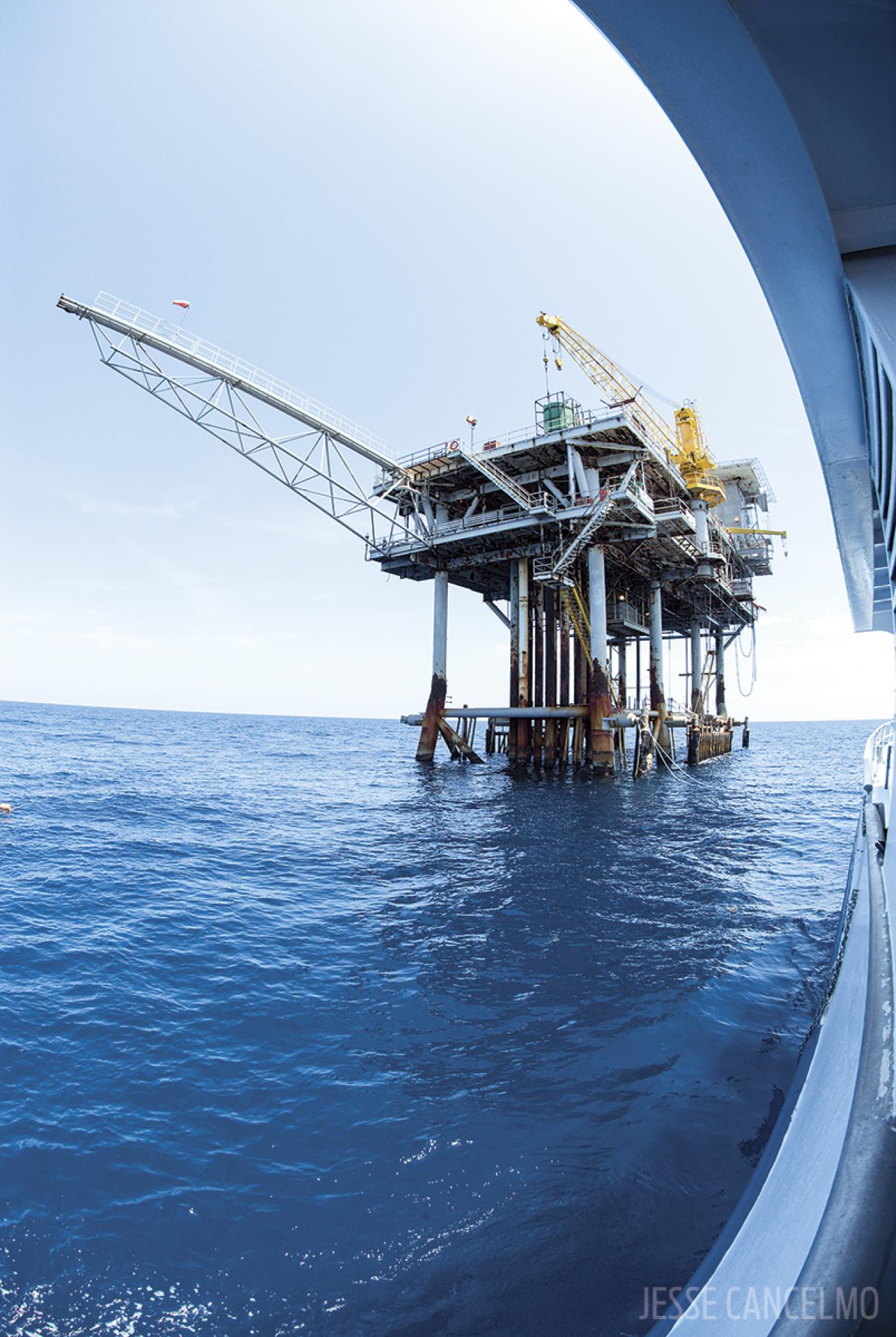
Jesse CancelmoOil rigs add another sight to sea as you travel the East and West Flower Garden Banks
There's more diving to do in Texas — scuba diving in the waterways of central Texas

